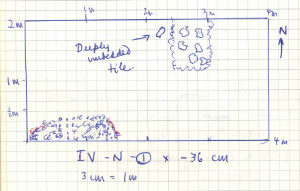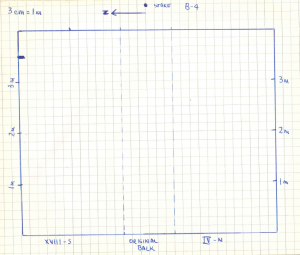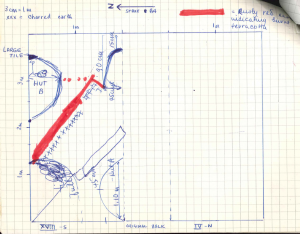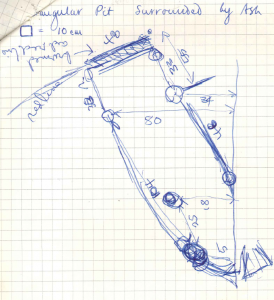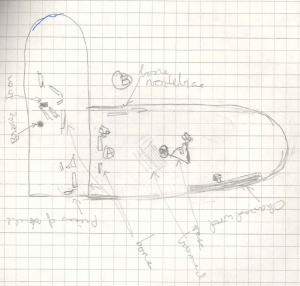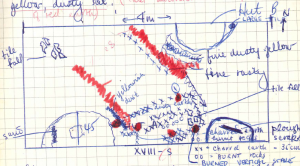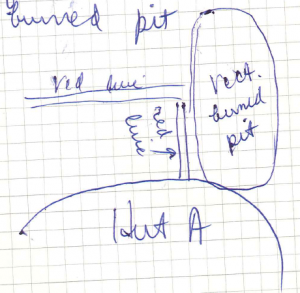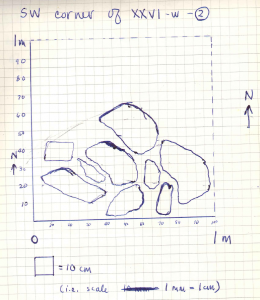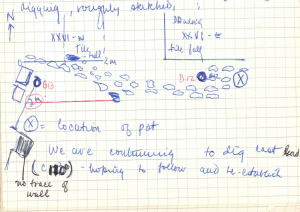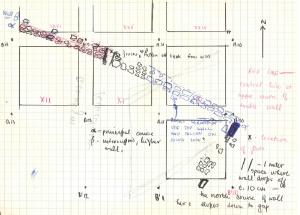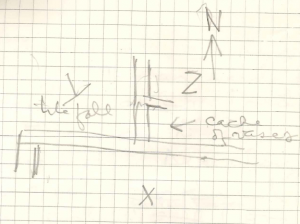This page contains the transcribed notes from 1974 Pizzica Field Notebook 1
Pizzica 1974, Notebook 1
27 June 1974
The First Day
At 7:00 AM the weather is fully overcast, almost no breeze.
Continued clearing of surface fields on Square I. Have decided to dig in the southern half (i.e. 2 by 4 m) of the easternmost 4 m square: designated I–S. Joseph Carter is digging a test pit in the southwest corner, 1 m by 1 m.
Soil fields with small rocks that are rich dark brown in color; many small-featured rounded stones, pieces of tile, a small flint piece. N.B. rim of flat plate: black glaze piece. Ceramic finds as well as tiles. At ca. 6–7 cm larger rocks are encountered. Traces of charcoal, perhaps another level. Piece of red figure, 4th c. BC. Many small fragments of pottery.
Three workers arrive at 7:25 AM.
Level 1
Beginning at west end of rectangle, a few large stones, small piece of iron: flat, thin, undecorated. Several chunks of Roman ware as well as predominantly Greek. Terra sigillata? Greek pieces of differing black highest-quality glaze, shinier than others (5th c. BC, imported?)
At 30 cm in test pit, encountering a layer of hard pebbles. Color of the earth is redder, less brown and sandy, more clay-like.
- Giuseppe di Taranto
- Alfredo #1
- Alfredo #2
Find #3: fragment of red figure with white over-painting; mid-section, left forearm of female figure; 6.8 cm wide/3.6 cm high; c. 10 cm down and c. 50 cm from south and east edges of Layer 1. Possibly Athena.
Layer 1 is plowed land. At 20 cm depth, the earth is composed of more clay then changes to chunks of yellow/gold earth. Still finding pieces of 4th c. BC Apulian figure and tile, some with white over-painting, and some large ribbed fragments singular to surface tiles. The yellow clay found in the earth is becoming darker, richer looking and filled with many small rocks.
At 26 cm, we are encountering what appears to be a patch of yellowish and whitish mixture of cement and small rocks in the southwest corner. One of the workmen—di Taranto—suggests this is virgin earth. A large rock at the eastern wall of the trench, its top at 13 cm depth, c. 2.4 m west of stake AI (AI 2.4 x – A61.1 x – 13). Layer of yellow earth and pebbles extends over the trench; in going through this layer, we encounter Layer 2.
Level 2
IV–N 1
Although there are still many fragments of tile in this area, there appears to be fewer fragments, shards, than in I–S 1.
Lunch break.
13:00 – the weather is hazy overcast; a fresh sea breeze
Just before beginning afternoon digging, one of the workmen found a votive face with black paint.
Find #4: 2 m north of eastern rim of III–N on the surface. Part of a face (eyes and nose) of votive plaque female figure.
The soil at the top level of IV–N 1 is almost identical to that of I–S 1. Perhaps IV–N is slightly looser. Finds: black glaze, some red figure.
I–S
Between Levels 1 and 2 directly west of the stone described above is a layer of natural conglomerate stone composed of large rounded pebbles. Workmen are digging in only the eastern half of the trench to determine if we have reached virgin soil.
Level 2 at this most superficial digging is more rocky and more densely compact than Level 1. It is, when broken up, lighter in color than the bottom of Level 1.
After reaching a depth of 34 cm in the southeast corner of the trench, JCC has decided to abandon digging in this area, since we have definitely encountered un-worked earth containing no material. A decision has been made to start at square IV north (IV–N).
Several fragments of Roman pottery from Level 1, as well as occasional pieces of bone, many tiles, pottery – many black glaze.
Find #5: sherd; draped female figure, red-figure, 5.8 cm high x 5.8 cm wide, with arm extended; traces of white detail.
Soil is generally looser, less compact, perhaps indicating there will be more below. Workers have halved off the western end of the trench to determine whether or not bedrock soil is immediately (or approximately) below. Sherds are becoming scarcer, soil composition is thus far unchanged. In cutting back into the eastern half of the trench, sand is discovered.
Find #6: base of small terra-sigillata cup
At the confine of Level 1 plowed earth, and Level 2 in the northeast corner of IV is a large piece of conglomerate stone. To the south is virgin earth (yellow sand and fine rock). To the north the soil is dark and fine. Tiles are deeply embedded. This is perhaps a cut. It begins about 30 cm from the trench wall. The conglomerate is 35 cm down from the edge of the trench wall. The coordinates are A-4 4.30 x A-5 4.90 x – 35.
28 June 1974
The Second Day
7:05 AM – the weather is partly cloudy, with the sun already very bright and very warm; the air is cool, no breeze
7:15 AM – di Taranto arrives, both Alfredos
As workers shovel out small amounts of dirt remaining in IV–N 1 from yesterday’s work, IC and NF are driving stakes to cut a new 4.0 by 2.0 m rectangle north of IV. Workers digging deeper into the western half of IV–N 1 are finding large and numerous tile fragments.
The southwestern corner of this trench (IV–N 1) 2.70 m from A-5 and 4.70 m from A-4 there is a cut of a foundation through the southwestern edge of the trench, projection c. 30 cm at level – 36 cm.
Photographs taken.
Workers are now digging XVIII–S 1 directly north (1.0 m balk) of IV (worker di Taranto is continuing to sweep and explore carefully in IV–N). Cutting into XVIII–S 1 immediately below the surface, soil is chunky, dry light brown—the same plowed earth as I–S and IV–N. Finding tiles, fragments of black glaze and Apulian red figure(?) in equal proportion.
Note: 2 small fragments in the southwest section of XVIII–S 1; one piece of red figure pottery showing a draped figure (?), measuring 4.5 cm x 2.0 cm; the other fragment showing black and red polychromy. In the center of the pit, a small pocket of rusty red earth was found.
In the southeast corner, the earth comes up in big chunks of yellow clay—the sort that we have been associating with virgin earth. This appears to have been turned up with a plow. There is a layer of charred wood. In the chunk examined the charred material occurs between the yellow clay and the brown earth.
At ca. 25 cm, 40 cm from the mid-point of the northern edge of the trench, is a patch of rusty red earth c. 18 inches in extent and flanked by yellow, dusty soil (later discovered to be only north of red earth).
At this level of the trench, we are still finding sparse scatterings of black glaze sherds. This red earth, plus an increase in the number of small stones and sandy earth probably indicates we are reaching the bottom of Level 1 and getting (CUT OFF?)
1 July 1974
Pizzica
Tomb 1
The entire tomb is surrounded by a thin line of ash. After the hard-packed dirt was cleared, the whole surface of the tomb was ash. Bone began to appear and a few broken bits of pottery (no indication that whole pots had been deposited in the grave—perhaps the sherds shifted down from Level 1). Fragments of skull found in east end and vertebrae found in the middle. In the middle also were several chunks of iron mixed with the bone.
Find: Just above the iron (to the east), a large bit of bronze. Clearly the body was laid out in the tomb in the east–west direction with few ornaments of metal. It was burned, probably in the coffin. This would explain the regular outline of burned wood and the position of the skeleton
Tomb 2
Beginning to dig from the level of the red lines. At first the soil is full of small rocks with no material. We first encounter bones (sample A). Then at the midpoint along the northeast wall of the tomb. Tiles are embedded in the northwest end of the tomb.
Southwest wall of the trench found by T–C tiles turned up on edge (?) they disintegrate because burned.
Northeast wall of the trench there is a long strip, c. 50 cm of burned wood. Perhaps the bottom plank of a coffin. This is at a depth that the whole tomb could have been covered with tiles, the coffin inside, and burned.
Sample A from the southeast end of the tomb are large, un-burned bones from a higher level than the rest. Sample B comes from the southwest corner of the tomb, amidst burned wood and T–C.
2 July 1974
A burned layer, uniform over the floor occurs at a greater depth than that of Tomb 1. Just above it in the center of the tomb is the bottom of an amphora with point turned up. Chips out of it were bagged yesterday (1 July) in the Tomb 2 bag.
Revision: “The tiles turned” up on end are probably just burned earth. The tile at the end of the trench area is not in the tomb, but not in virgin soil or tilled earth either —perhaps belongs to another tomb.
Under the amphora are found large quantities of burned bone. The layer of ash and bone cleared. No further ceramic material found. The amphora was clearly burned.
Hut A, XVIII–S 1
In the southwestern corner of XVIII–S cut through 1 and down into 2.
Floor of the hut: traces of very fine ruddy soil and some yellowish traces. Pieces of bone, fluit impasto pottery found. Patches of sand.
Just east of the hut, at the bottom of the plowed earth—i.e. Level 1—we have encountered a layer of burnt earth, with a mixture of more rusty red and yellow dusty soil. At just about the same level of the hut floor (c. 40 cm)—i.e. at 36 cm—is a layer of burned earth and burned rocks. This is about 25 cm outside the circumference of the hut.
Between the two sections of rusty red soil (shown on drawing of XVIII–S) is earth which has been disturbed. Following the first line of red in a northwesterly direction—about 1 m from the northwest corner—is a tile fall which is slightly above the red earth. Above the tiles was found a bone. This was possibly brought there by the plow. At the center of the trench at this level is some burned bone amidst the charred earth.
Note: foot of pot with black glaze, possibly archaic (?) was found in the burnt layer at the central pit. Also pieces of bone were found. This charred area is wider; it’s difficult to know if this pottery is from the level directly above.
Note: burned handle of a cup
Note: piece of archaic cup
12:20 PM – the weather is sunny, hot with little breeze
Pieces of bone from the charred area. At 35 cm, 20 cm from the southern edge of the trench, we found evidence of a plow (i.e. a scrape) c. 30 cm long and 3.0 cm wide.
At the walls of Hut A, Level 1 is peeled easily away, like onion skin, through virgin earth down to Level 2.
In the rectangular charred area (see plan), c. 35 cm from the south wall and 43 cm, there is evidence of a vertical stake which has been burnt off. It is located 2.20 m from stake B-4 and 3.10 m from B-5.
At Hut B, where a large tile fragment has been found in the earth, we are having difficulty in determining what is virgin earth and what is the cutting of the hut.
The two lines of red fine earth of supra parallel one another in a striking fashion (see drawing). On the more northern red line runs a line of charred material, approximately 50 cm in its extent from the northern edge of the trench.
While clearing up the trench for photography, we have uncovered 4 more charcoalized stakes (see drawing). There is a great deal of charcoalized bone in the perimeter of this rectangle.
Notes:
- With the discovery of Hut A, we began keeping a separate box for material. Therefrom, it consists of bone, impasto pottery. Encountering red lines, we began keeping a box of burned material 1/2 consisting of bone and some ceramic (sp?) archaic material.
- Hut B finds were kept separately, and consist of many more impasto finds.
- Burned red strips – terracotta.
- Note, we will take samples to UT for carbon-14 testing.
- Huts with impasto ware seem non-Greek.
- Rectangular burned with stakes:
- JCC thinks it is a shrine
- workmen think it is a tomb
- D’Andria thinks it is a hut
- We’ll be looking for embedded wattle and daub walls
1 July 1974
The Third Day
7:00 AM – we and the workmen arrive simultaneously; the weather is clear sky, bright sun, cool air with a brisk breeze
Workers are removing the last half of balk between IV–N and XVIII–S in order that we might obtain better pictures of the cut observed in the southeast corner of XVIII–S and the northeast corner of IV–N. JCC is making a detailed drawing of the floor of XVIII–S. NF is assisting JC. BE is supervising the workmen, taking measurements of floor depths of XVIII–S (measurements on a vertical taken from the base of stake B-4).
Hut B
47 cm/48 cm
Hut A
47 cm/53 cm
Red line—northmost 46/48 cm
54—nearest trench wall/ 47—nearest hut/ 40—nearest southeast cut
Tile full 49/53 cm
Southern Red Line
@ (sp?) fall —57
near rectangular (sp?) 46
Stake 45, 47, 49
Rocks 40
Out of digging at balk
- tile fragments
- black glaze —some very thin
JC and BE have continued to work very carefully and cautiously in removing soil around the rectangular area with burned material, the two red lines and the possible hut/cut in the southeast corner. We have found a collection of tiles (fall?) under what was previously balk, i.e. 40 cm, 105 cm from the east wall of the trench—Hut C? Area with burned perimeter appears to be about the size of a grave.
We have also found a group of tiles at the southwest end of our burned rectangle. Southwest, rounded edge of the burned area is tangential to the tall of Hut A. The burned material, which is some
At the southwest end of the rectangular burned area rises c. 10 cm higher of Hut A, where 2 pieces of impasto are in situ. The mound at the end of the rectangular burned area consists of the same hard soil found inside the perimeter of the charcoal full of rocks, which constitutes hut floor. Soft brown soil lies under several 8.0 cm long and smaller charred stones. The corner of the rectangular pit surrounded by ash appears to cut into the wall of Hut A. Also in hard brown soil are a number of tiles.
The southerly red line flanks the edge of the rectangular burned pit.
Embedded in the burned area is some pottery. Hard brown earth covers over virgin earth. Pieces of pottery were found in the brown earth under charred material.
XXVI–W
While JC is completing detailed drawings of XVIII–S, workers have begun digging XXVI–W, which lies c. 1.5 m due west of the tile fall which was discovered by F. D’Andria for the Soprintendenza, October 1973 (excavated by di Taranto) and which helped lead to the decision to excavate at Pizzica. NF spent last Friday, 28 June 1974 and the earlier part of this morning in clearing up this trench and preparing it for photographing.
This surface soil resembles that which we have found farther up the hill, i.e. due east, although the former seems slightly more moist, i.e. not so dusty and coming up in bigger hunks.
There is a large amount of tile fragments just beneath the surface. Only a few pieces of bone have been found in Layer 1, piece of iron.
At c. 13 cm in the southwest corner of this trench, we have found the top of what appears to be an ancient wall. Beginning 1.10 m down the west wall from the northwest corner, a tile fall was discovered at 26 cm; 1.35 m wide along the west wall.
At this point, this tile fall is—by eye measurement—visually higher than the tile fall in the adjacent XXVI–E.
1:15 PM – for the afternoon digging, we have decided to halve XXVI–W along the north–south axis. We will be watching especially for finds behind our wall, and will dig down through our tile fall. We will keep all those fragments which we remove in order to approfundere.
At the level of the tile fall, the earth is packed and very hard; the workers are digging at a noticeably slower pace. Just north of the level of the tile fall, the earth is becoming much darker in color—almost black—and softer. There are still fragments of tile coming up.
Below the level of the wall, the soil is a tan clay which comes up in big hunks. It contains large quantities of tile next to the wall, and below the main visible layer of the tile fall.
Find: piece of archaic post with red and black concentric rings around the rim, measuring 4.0 cm x 2.0 cm x 1.7 cm. It was found under the tile fall, c. 10 cm.
Work concluded, a decision was made to continue digging deeper using the 2 Alfredos until di Taranto has completed his work in XVIII–S of infra for description of today’s excavations in XVIII–S.
Two Alfredos will follow the path of the wall to attempt to discover the nature of the structure of which this forms a part.
2 July 1974
The Fourth Day
7:00 AM – all arrive a’ l’heure; weather is clear, cool with no breeze and warm sun with the promise of a hot day
We are continuing our digging down in XXVI–W 2, below the fall which we found yesterday, and in front of (or behind) the wall in the southern end of the trench. We are finding almost no tile fragments now, and only occasional fragments of pottery.
We have found several small pieces of bone in the wall of the trench directly beneath the wall in the southwest corner. This comes from Layer 3, which appears as a moister layer 13 cm below the beginning of Layer 2.
After following layer 3.0 to 14 cm, we have ceased digging in trench XXVI–W and have turned in a southwesterly direction to pursue the course of the wall discovered in XXVI–W 2 at 13 cm in the southwest corner. We find immediately that the wall does not run southeast and are digging northwesterly and northeasterly. We are keeping a separate box for fragments found between the ground surface and the top of the wall: a few sherds are coming up from the top, along with many fragments of tile.
The line of the tile fall in XXVI–W 2 runs slightly above (almost equal to) the top of the wall.
1:10 PM – we spent from 9:30 to 12:00 following the top of the wall. We have decided to remove the plowed earth (Layer 1) from along the entire top of the wall, and after that to dig a series of deep trenches which run perpendicular into the wall. Work goes well, but slowly, since the earth here is very hard and the heat high with little relieving breeze.
We are now following a section of the wall which runs NNE and will, at least for some portion, parallel di Andria’s trench of discovered tile fall.
The earth here, as with every place that we have dug thus far, is ploughed land which has been worked in recent times. On a large wall stone 80 cm north (and slightly west) of stake B13, we found a large plough scrape at 11 cm as measured from the base of B13 (the plow scrape measured 0.80 m from B-13). In the section of the wall (running SSW from XXVI–W into XIII–E) we have found a piece of glass (from a modern bottle?) at a depth of 28 cm!
At 1.0 m due east of B-12 at 40 cm, we have discovered a number of pots under the tile fall —this due north of the wall (photographs taken). We have also found some pieces of bone, some burned material.
Thinner wall, buff colored coarse ware under one large tile, pieces shattered, base up, pieces surrounded in a circle. Obviously the pot was whole when the roof fell—this would perhaps lead us to conclude the date of the falling in of the roof, and perhaps leads us to conclusions concerning this farmhouse’s falling into disuse. Difficulty in pursuing the path of the wall, shifting stretch. Black earth turned up just north of the double wall. Alfredo #1 dug SSW across portal.
Find: white glass, north of double wall measurements
Find: fragment of bone found with buff-colored pot
3 July 1974
The Fifth Day
Weather is cool; clear sky and warm sun with little breeze.
Our purpose today will be to attempt once again to follow the top surface of our (house? stable?) wall and to make some sense of the double wall (which we discovered yesterday on the south side of B-12).
Yesterday’s digging, roughly sketched:
We are continuing to dig last lead (c. 110°), hoping to follow and re-establish no trace of wall. Pursuing our easterly course, the soil coming up—from over the double wall is moister, darker—almost black and softer. This indicating this particular earth has been used for vegetation.
Alfredo #2 is clearing at XVIII–S (the dirt from yesterday’s excavation of NF) and digging down in the northwest corner pit.
Find: lead, semi-circular piece, measuring 4.6 cm across, 3.0 cm wide, found c. 2.0 m east of B-12 (and in the balk between XI and XXV, Layer 1).
The double wall which we are following measures, at B-12, 1.0 m wide and is made up if 4 courses of stone (2 courses per level of the wall). The perplexing question at the moment is: why these two levels? Alfredo #1 suggests that the higher, i.e. northern course of the wall, may be a section which has fallen from its adjacent section. This would be impossible however, because the higher course is in a perfectly cut line—there is nothing fortuitous about its position. The higher course is 9 cm above the lower. The upper course runs 110°E—at B-12.
Find: remains of pot #2 found on north side of the wall, at wall level, Layer 2 (also a small piece of bone, 1.80 m from B-12). Purkish ware, large stone amphora found upside down with no tile found directly above it (photographs taken in situ). Would seem to strengthen our belief that the north side of the wall was the interior of a building.
From layer 1, a piece of “loomweight” with geometric patterns—from south side of the wall, 1.50 cm c. of pol
At 1.30 m, 104°ESE of B-12, the wall drops off ca. 10 cm and leaves a gap of c. 0.50 m before the lower (i.e. southern) course resumes. Ca. 1.0 m after this resumption, several rocks seem to lie—as if fallen—against the northern side of this lower course. At 45 cm further east, the upper (i.e. northern) course of the wall resumes also.
As we continue digging in ESE direction, our double wall continues. There are very few pottery sherds coming up, although there are still many fragments of tile. Perhaps when the house was abandoned, the inhabitants moved everything out except several pots which either were not needed during the move or perhaps were defective.
The higher, i.e. more northernly course, is one again broken down midway between B12 and B11, and re-begins after a 1.50 m interruption, suggesting that this wall was older and fell into disrepair, and was then replaced by the southly, lower course. This one is more solidly constructed and in a batter state of preservation.
Along the northerly side of the present trench, mid-way between B-12 and B-11, and running up to the trench wall in front of B-11 there is evidence of another tile fall.
- southerly course — Alpha
- northerly course — Beta
4 July 1974
The Sixth Day
7:00 AM – the weather is clear sky, cool air, warm sun, and little breeze
All three workers continuing the work on which we were engaged all day yesterday, following our wall in an ESE direction.
Measured north/south on a line between A-11 and B-11, the northern course of the wall is ca. 2.2 m from B-11. Since we are digging uphill, the digging takes longer to remove the top soil from the wall. The earth contains a gathering of tile fragments and practically no pottery sherds.
At 1.35 m due east of A-11 (for the southern wall of the trench) we have decided to reduce the width of the present trench by about half in order to hasten the digging over the lower, i.e. southern course of the wall.
The earth atop each course of the wall is identical. The only exception to this was over the break in the northern course (cf. notes 3 July 1974) where the earth was a rich dark/black color indicating vegetation above.
Find: bronze nail with round head, measuring 2.5 cm long; the head has a diameter 1.4 cm from X–S 1.
We have removed stake A-10 since the wall passes directly under.
At several places along the wall, a plow has perhaps scraped part of the wall so that rocks have fallen along the south side (these lower “fallen” rocks may also be the walls of rooms leading off the main wall). Finally just before lunch we think we have come to a turn (break?) in the wall. At approximately under where the stake A-10 was driven, we have found that the wall turns c. 90° SSW, i.e. to approximately 200°.
This new section of wall is found to be “too intermittent” in the first two meters to determine whether or not it constituted one of the principle walls of the building. It will probably be necessary to dig deeper in order to determine if this formed a main wall. The soil in which we have been digging since turning SSW is the same ploughed earth which we have encountered all along. However, there seems to be an almost complete absence of pottery sherds, as well as a real decrease even in the number of tile fragments.
5 July 1974
The Seventh Day
Weather – bright sun, slight breeze; the air is not so cool as usual for this time of day
Vertical measurements from the surface of the trench to the top of Wall Alpha:
- at the line between A-10 and B-10: 27.0 cm
- at the line between A-11 and B-11: 27.5 cm
- at the line between A-12 and B-12: 32.0 cm
Our main purpose today is to follow the wall surface in a SSW direction and probably to attempt to anticipate some of the lower course by breaking off at some point in the present trench and moving down the hill.
In the first 2.0 m after turning SSW, the wall continues to show evidence of having been torn by the plow. We have suspended digging at a point along B’ east-west axis —at approximately B’-10— and have moved down the hill c. 3.0 m to dig a soundage (midway between B’-11 and C’-11) to determine the course of our wall.
Find: “loomweight” from soundage between B’-11 and C’-11, Layer 1; 6.0 cm long x 3.2 cm x 2.4 cm. We have decided in this soundage to dig to virgin earth.
At c. 40 cm on the northern side of our soundage, we have found the tile fall. This marks the end of Layer 1 and the beginning of Layer 2. If we are over the course of the wall, we should encounter it below this level (cf. northern wall of trench, which led from XXVI–W in a ESE direction to A-10 (i.e. our 16 m wall whose eastern corner we turned yesterday).
In our soundage, northern wall:
- Level 1 —surface to ca. 38 cm
- Level 2 —ca. 30 cm
- Level 3 —
These show the same color and texture differentiation as the western trench wall of XXVI–W (cf. drawing of section of XXVI–W made 3 July 1974).
- 50 cm—tile to eastern wall
- from tile to edge of Hut B—1.40 m
- from edge of Hut B to Red Line—0.90
- from Red Line to edge of trench—1.10
Hut B at its widest is 62 cm, 50 cm from its eastern edge.
Red Line at its furthest extent is 1.15 m from the trench wall, and is opposite to Hut B at its widest point.
Red Line—6 cm.
Between the Red Line and the hut is virgin earth (yellow sand and pebbles).
Second Red Line—80 cm off from the first, i.e. northern red line.
Hut A—45 cm at apex.
Stake 1—56 cm from south wall, 120 cm from east wall
8 July 1974
The Eighth Day
Work begins at 7:07 AM. We have decided to turn our attention to finding the north wall of the building, the roof of which is represented by the tile fall in section XXVI. We begin by removing the small projection where stake B-12 stood. Under this there is some indication of a transverse wall. We will widen the trench of October 1973 in area XXVI. The wall runs along the line between XXV and XXVI.
Nelson is employed in removing the dirt piled up beside the trench (G. suggests that the way to find the lower wall parallel to our x is to cut a transverse trench about 15 m to the south. This we will do later.
Layer 1 is above the tile fall and the wall—sherds of coarse ware.
Wall confirmed by further stones. It extends at least 4.0 m north where we have encountered large blocks.
The morning is spent in widening the trench to uncover the transverse wall, and in clearing off the tile fall for photographing. Many unusually large and nearly complete tiles. The wall turns out to be formed of large blocks like those in X–W. These also have plow marks in the east-west direction.
Just to the east of the tile wall and to the north of the doubled wall X–N Beta–S are more vases buried upright in the ground. These go with those discovered by BE on 2 July (?). The transverse wall Beta–W seems after about a meter to turn east, as if to form a small room (pantry?)
We decided to widen farther the trench over the transverse wall—1.0 m further to the east, still in square XXV. We are over Room Z. There appears also to be a tile fall over Room Z, but it is higher and thinner than that over Y.
This afternoon went with Giuseppe along the canal at the foot of the hill, walking east from Conarete Bridge we see in the east wall of the canal large blocks projecting from either side. Two sets spaced about 5.0 m apart looks as if the canal cut through an ancient building. The archaeological stration is about 1.0 m below the rich black surface soil. All along tiles are embedded in the wall. Farther east on the south bank we see two groups of vases and bone (sp?) and make a collection—and box it. See Canal Wall 8.vii.74. It is coarse ware but unusual shapes. There is one large tile fall on the north bank.
I later proceeded as far as the point where our spring joins the canal. There archaeological material is scarce. It would appear that whatever habitation, sanctuary, etc? was here below out farmhouse.
It would be nice to explore but must talk first to Indice-Canal belongs to Consozio Bonifica, which also ought to have a detailed map of area. The canal here recently has been widened. The (sp?) cut above and the concrete walls broken up. Many blocks of concrete around too.
Among the tiles in the extension to the east, appear vase fragments including complete rim and bone. These form as closest for dating the fall in as they were clearly broken by the fall and remained in place. Also several fragments of bone.
Find. _____
